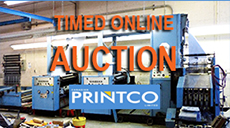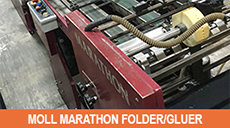
|
|
| Home › Articles › Here |
Asleep At The Wheel? |

|
|||||||||||||||
| By: Nick Howard | Date: December 2011 | Contact the Author |
||||||||||||||||
November 25th’s announcement by manroland was shocking but not really surprising. Sounds rather silly in that context, but similar to learning of the death of a loved one you know is terminal - shocking still but not a surprise. Dominant is a word that can be used in describing manroland - especially during the heyday of print. Having been purchased by the giant MAN Group (Maschinenfabrik Augsburg und Nürnberg) in 1979, Roland (Faber & Schleicher) was a leader in mid to large format sheetfed machines. By 1989, MAN purchased Miller and combined the two companies. manroland continued to be a major influence and instrumental inventing key functionality to press equipment. In fact, much of what they have developed has been copied by others including: air transfer, vacuum feedboard, pneumatic side-guide, bender-less plate loading, computerized make-ready, plate cylinder de-clutching, on-press cold foil, closed loop color control, and the first widely accepted off-press control console. These are but a few. manroland had also stubbornly stayed with their 5-cylinder concept much too long and this allowed companies like Heidelberg and Komori to gain ground. I recall a comment from a competitor in the late 80’s. He said he was always so pleased when arriving at Drupa, to see manroland’s 5-cylinder machine on their stand. Unitized presses was where everyone else was going and manroland, with its 9-sided transfer machines, almost seemed hard headed about changing. New ideas of press automation made it impossible to integrate into a 5-cylinder press, and everyone, it seemed, except manroland, knew it. One could say the 700 launch, fraught with early problems, is conceivably the beginning of manroland’s struggles. Had the press stabilized faster and not received so much negative publicity (in the early to mid 1990s), it really was the best engineered piece of equipment available at that time. |
||||||||||||||||
 |
||||||||||||||||
During the late 1990’s, manroland also put the squeeze on its wholly owned sales and service businesses and many employees either found the door or were shown to it. Sales commission structures changed drastically as factory led stubbornness on sale prices created a severe drop in orders. With the associated difficulties in reliability and lower sales this precipitated the slow decline in sheetfed earnings. But manroland can be defined as two major builders - a sheet-fed and a web-fed business. Web, which was always the ace card with such notable brands as the world-class Rotoman and Lithoman, continue as market leaders. Perhaps, this helped to mask the underlying issue of the group’s profitability? Both Goss and KBA are crying crocodile tears now a,s although web has been hard hit by the financial downturn, having the #1 player stumble creates some breathing room. Was the November 25th announcement self induced or was it something else that caused the insolvency? Unlike much of what has been published to date, I don’t succumb to the reasoning of poor management. All three of the German press builders have knowledgeable leaders that have been in the industry a very long time. manroland had basically two major shareholders; Allianz and MAN. Both seem to have decided not to continue funding huge losses. They may both opine that these [losses] occurred because in this day and age, much of what was a necessity to be printed is now in cyberspace and available quicker and faster through wireless devices hooked to the internet. Besides the obvious shrinkage, severe financial restrictions for printers buying machinery, has meant over 50% of overall new press sales have disappeared. No company could stand this for long. Some competitors possibly handled the downturn better by branching out into other markets - consumables for one, and in Heidelberg’s case, building machines in China. But, all three of the German companies have the same difficulties, but only manroland turned out to be the most fragile as they have lost the most in market share and had nowhere to turn. Both Heidelberg and KBA are relieved somewhat and probably also hope the Roland sheetfed program does not get a second life in China or elsewhere. At the turn of the century travel from Europe to North America could only be done by ship. Competition from shipbuilders in Europe and England was fierce. Larger and faster ships were being designed and built. Luxurious interiors added. Then, as if overnight, Boeing introduced the 707 Jet and what seemed a blue chip industry fell apart and resulted in a very painful and slow death. Now though ship travel has stabilized as vacationers want to travel on luxury liners for holidays and huge oil tankers and container ships are in constant demand around the world. Print could be in that period of time when the 707 made travel faster and less expensive. Shipbuilding like printing press construction, needed to change. Areas less affected by new technology [packaging and web-to print,] will need to be served by smaller more agile machine manufacturers. |
||||||||||||||||
|
|||||||||||||||





